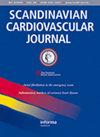机械瓣膜置换术与生物瓣膜置换术治疗先天性二尖瓣感染性心内膜炎的远期疗效比较
IF 1
4区 医学
Q3 CARDIAC & CARDIOVASCULAR SYSTEMS
引用次数: 3
摘要
抽象的目标。目的探讨二尖瓣置换术与生物瓣膜置换术治疗先天性二尖瓣感染性心内膜炎的远期疗效。设计。我们对2004年至2017年在芬兰接受二尖瓣置换术治疗先天性二尖瓣感染性心内膜炎的年龄≤70岁的患者进行了一项回顾性、全国多中心队列研究。结果。终点是全因死亡率、缺血性卒中、大出血和二尖瓣再手术。根据基线特征(年龄、性别、合并症、药物滥用史、合并手术、手术紧急程度和手术中心)对结果进行了调整。中位随访时间为6.1年。机械假体的12年累积死亡率为36%,生物假体为74% (adj. HR 0.40;置信区间:0.17—-0.91;p = 0.03)。随访时,19%机械假体患者发生缺血性卒中,33%生物假体患者发生缺血性卒中(p = 0.52)。12年随访期间,机械假体的主要出血率为30%,生物假体为13% (p = 0.29)。机械假体二尖瓣再手术率为13%,生物假体二尖瓣再手术率为12% (p = 0.50)。药物滥用史对结果没有显著的改变作用(死亡率的相互作用p = 0.51,次要结局的相互作用p≥0.13)。结论。在非老年先天性二尖瓣感染性心内膜炎患者中,与生物假体相比,机械二尖瓣假体的使用具有较低的长期死亡率。该患者组常规选择生物二尖瓣假体的结果不支持。本文章由计算机程序翻译,如有差异,请以英文原文为准。
Long-term outcomes of mechanical versus biological valve prosthesis in native mitral valve infective endocarditis
Abstract Objectives. To study the long-term outcomes of mitral valve replacement with mechanical or biological valve prostheses in native mitral valve infective endocarditis patients. Desing. We conducted a retrospective, nationwide, multicenter cohort study with patients aged ≤70 years who were treated with mitral valve replacement for native mitral valve infective endocarditis in Finland between 2004 and 2017. Results. The endpoints were all-cause mortality, ischemic stroke, major bleeding, and mitral valve reoperations. The results were adjusted for baseline features (age, gender, comorbidities, history of drug abuse, concomitant surgeries, operational urgency, and surgical center). The median follow-up time was 6.1 years. The 12-year cumulative mortality rates were 36% for mechanical prostheses and 74% for biological prostheses (adj. HR 0.40; CI: 0.17–0.91; p = 0.03). At follow-up, the ischemic stroke had occurred in 19% of patients with mechanical prosthesis and 33% of those with a biological prosthesis (adj. p = 0.52). The major bleeding rates within the 12-year follow-up period were 30% for mechanical prosthesis and 13% for a biological prosthesis (adj. p = 0.29). The mitral valve reoperation rates were 13% for mechanical prosthesis and 12% for a biological prosthesis (adj. p = 0.50). Drug abuse history did not have a significant modifying impact on the results (interaction p = 0.51 for mortality and ≥0.13 for secondary outcomes). Conclusion. The use of mechanical mitral valve prosthesis is associated with lower long-term mortality compared to the biological prosthesis in non-elder native mitral valve infective endocarditis patients. The routine choice of biological mitral valve prostheses for this patient group is not supported by the results.
求助全文
通过发布文献求助,成功后即可免费获取论文全文。
去求助
来源期刊

Scandinavian Cardiovascular Journal
医学-心血管系统
CiteScore
3.40
自引率
0.00%
发文量
56
审稿时长
6-12 weeks
期刊介绍:
The principal aim of Scandinavian Cardiovascular Journal is to promote cardiovascular research that crosses the borders between disciplines. The journal is a forum for the entire field of cardiovascular research, basic and clinical including:
• Cardiology - Interventional and non-invasive
• Cardiovascular epidemiology
• Cardiovascular anaesthesia and intensive care
• Cardiovascular surgery
• Cardiovascular radiology
• Clinical physiology
• Transplantation of thoracic organs
 求助内容:
求助内容: 应助结果提醒方式:
应助结果提醒方式:


